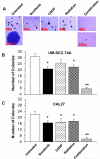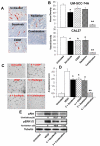Sorafenib enhances the antitumor effects of chemoradiation treatment by downregulating ERCC-1 and XRCC-1 DNA repair proteins
- PMID: 21551262
- PMCID: PMC3132282
- DOI: 10.1158/1535-7163.MCT-11-0004
Sorafenib enhances the antitumor effects of chemoradiation treatment by downregulating ERCC-1 and XRCC-1 DNA repair proteins
Abstract
Head and neck squamous cell carcinoma remains a challenging clinical problem because of the persisting high rate of local and distant failure due to the acquisition of chemo- and radioresistance. In this study, we examined if treatment with sorafenib, a potent inhibitor of Raf kinase and VEGF receptor, could reverse the resistant phenotype in tumor and tumor-associated endothelial cells, thereby enhancing the therapeutic efficacy of currently used chemoradiation treatment. We used both in vitro and in vivo models to test the efficacy of sorafenib either as a single agent or in combination with chemoradiation. Sorafenib, as a single agent, showed antitumor and angiogenesis properties, but the effects were more pronounced when used in combination with chemoradiation treatment. Sorafenib significantly enhanced the antiproliferative effects of chemoradiation treatment by downregulating DNA repair proteins (ERCC-1 and XRCC-1) in a dose-dependent manner. In addition, combination treatment significantly inhibited tumor cell colony formation, tumor cell migration, and tumor cell invasion. Combination treatment was also very effective in inhibiting VEGF-mediated angiogenesis in vitro. In a severe combined immunodeficient mouse xenograft model, combination treatment was very well tolerated and significantly inhibited tumor growth and tumor angiogenesis. Interestingly, following combination treatment, low-dose sorafenib treatment alone was highly effective as a maintenance regimen. Taken together, our results suggest a potentially novel strategy to use sorafenib to overcome chemo- and radioresistance in tumor and tumor-associated endothelial to enhance the effectiveness of the chemoradiation therapy.
© 2011 American Association for Cancer Research.
Figures






Similar articles
-
Differential modulatory effects of GSK-3β and HDM2 on sorafenib-induced AIF nuclear translocation (programmed necrosis) in melanoma.Mol Cancer. 2011 Sep 19;10:115. doi: 10.1186/1476-4598-10-115. Mol Cancer. 2011. Retraction in: Mol Cancer. 2021 Jun 15;20(1):92. doi: 10.1186/s12943-021-01378-8. PMID: 21929745 Free PMC article. Retracted.
-
Antitumor activity of sorafenib in human cancer cell lines with acquired resistance to EGFR and VEGFR tyrosine kinase inhibitors.PLoS One. 2011;6(12):e28841. doi: 10.1371/journal.pone.0028841. Epub 2011 Dec 9. PLoS One. 2011. Retraction in: PLoS One. 2024 Jan 25;19(1):e0298013. doi: 10.1371/journal.pone.0298013. PMID: 22174910 Free PMC article. Retracted.
-
Potent in vitro and in vivo antitumor activity of sorafenib against human intrahepatic cholangiocarcinoma cells.J Gastroenterol. 2011 Jun;46(6):779-89. doi: 10.1007/s00535-011-0380-3. Epub 2011 Feb 18. J Gastroenterol. 2011. PMID: 21331764
-
Sorafenib.Recent Results Cancer Res. 2010;184:61-70. doi: 10.1007/978-3-642-01222-8_5. Recent Results Cancer Res. 2010. PMID: 20072831 Review.
-
Sorafenib.Expert Opin Pharmacother. 2006 Mar;7(4):453-61. doi: 10.1517/14656566.7.4.453. Expert Opin Pharmacother. 2006. PMID: 16503817 Review.
Cited by
-
The effect of interleukin-17F on vasculogenic mimicry in oral tongue squamous cell carcinoma.Cancer Sci. 2021 Jun;112(6):2223-2232. doi: 10.1111/cas.14894. Epub 2021 Apr 7. Cancer Sci. 2021. PMID: 33743555 Free PMC article.
-
Application of molecular targeted therapies in the treatment of head and neck squamous cell carcinoma.Oncol Lett. 2018 May;15(5):7497-7505. doi: 10.3892/ol.2018.8300. Epub 2018 Mar 20. Oncol Lett. 2018. PMID: 29725456 Free PMC article. Review.
-
Recent advances in targeting DNA repair pathways for the treatment of ovarian cancer and their clinical relevance.Int J Clin Oncol. 2017 Aug;22(4):611-618. doi: 10.1007/s10147-017-1137-7. Epub 2017 May 15. Int J Clin Oncol. 2017. PMID: 28508305 Review.
-
Cross talk of tyrosine kinases with the DNA damage signaling pathways.Nucleic Acids Res. 2015 Dec 15;43(22):10588-601. doi: 10.1093/nar/gkv1166. Epub 2015 Nov 5. Nucleic Acids Res. 2015. PMID: 26546517 Free PMC article. Review.
-
Effect of sorafenib on cisplatin-based chemoradiation in head and neck cancer cells.Oncotarget. 2016 Apr 26;7(17):23542-51. doi: 10.18632/oncotarget.8275. Oncotarget. 2016. PMID: 27015558 Free PMC article.
References
-
- Leemans CR, Braakhuis BJM, Brakenhoff RH. The molecular biology of head and neck cancer. Nat Rev Cancer. 2011;11:9–22. - PubMed
-
- Ragin CC, Modugno F, Gollin SM. The epidemiology and risk factors of head and neck cancer: a focus on human papillomavirus. J Dent Res. 2007;86:104–14. - PubMed
-
- Kalavrezos N, Bhandari R. Current trends and future perspectives in the surgical management of oral cancer. Oral Oncol. 2010;46:429–32. - PubMed
-
- Allen AM, Elshaikh M, Worden FP, Bradford CR, Teknos TN, Chepeha DB, et al. Acceleration of hyperfractionated chemoradiation regimen for advanced head and neck cancer. Head Neck. 2007;29:137–42. - PubMed
-
- Dimery IW, Hong WK. Overview of combined modality therapies for head and neck cancer. J Natl Cancer Inst. 1993;85:95–111. - PubMed
Publication types
MeSH terms
Substances
Grants and funding
LinkOut - more resources
Full Text Sources
Research Materials
Miscellaneous

